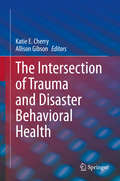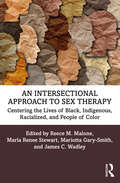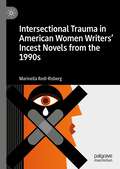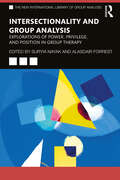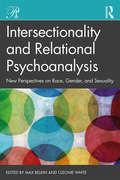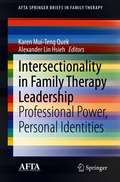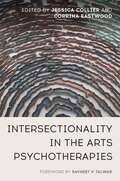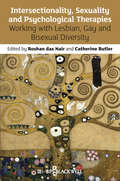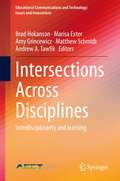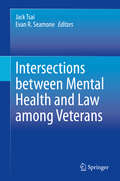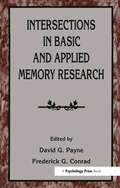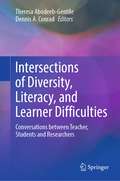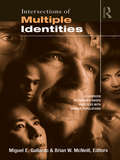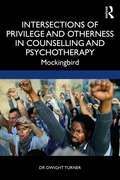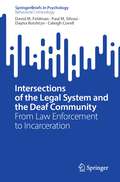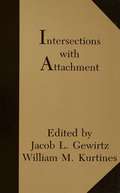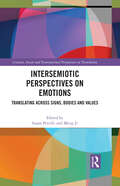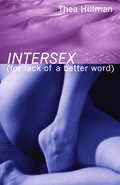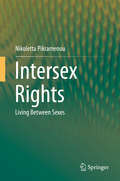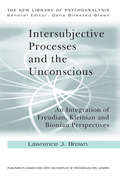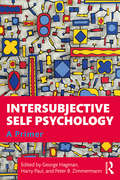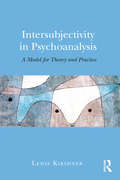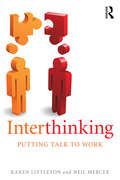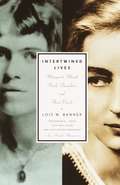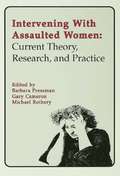- Table View
- List View
The Intersection of Trauma and Disaster Behavioral Health
by Katie E. Cherry Allison GibsonThis contributed volume examines the intersection of trauma and disaster behavioral health from a lifespan perspective, filling a critical gap in the literature on disaster mental health research. In the chapters, the contributors evaluate behavioral data of adults exposed to various environmental events in both the United States (i.e., the 2017 Hurricanes Irma in Florida and Harvey in Houston) and abroad (i.e., missile fire in the 2014 Israel-Gaza conflict). Contributors also suggest future directions, practices, and policies for trauma and disaster response. The three parts of the book provide an overview of disaster behavioral health across the lifespan, propose practical applications of research theories to psychosocial problems resulting from disasters and trauma, and evaluate disaster and trauma interventions from a macro-level perspective. Topics explored among the chapters include:Integrating Trauma-Informed Principles into Disaster Behavioral Health Targeting Older Adults Cultural Competence and Disaster Mental Health When Disasters Strike: Navigating the Challenges of “Sudden Science” Frameworks of Recovery: Health Caught at the Intersection of Housing, Education, and Employment Opportunities After Hurricane Katrina Substance Use Issues and Behavioral Health After a Disaster Psychosocial Recovery After Natural Disaster: International Advocacy, Policy, and RecommendationsThe Intersection of Trauma and Disaster Behavioral Health is a vital resource for researchers whose expertise covers the domains of trauma, health and wellness, and natural and technological disasters. The book also is a useful supplement to graduate courses in psychology, sociology, social work, disaster science, human ecology, and public health.
An Intersectional Approach to Sex Therapy: Centering the Lives of Indigenous, Racialized, and People of Color
by Reece M. Malone Marla Renee Stewart Mariotta Gary-Smith James C. WadleyWhen a Black, Indigenous, or racialized individual or relationship works with a sex therapist, a host of cultural circumstances can contribute to intimacy discord and sexual dysfunction. This collection brings together clinicians and educators who share their approaches, bridging sex therapy with a client’s relationship to their racial, cultural, and ethnic identity. This essential book aims to enhance therapists’ supervisory practices and clinical treatments when working with culturally diverse and marginalized populations, fostering greater understanding and awareness. Innovative tools that integrate the impacts of acculturation, minority status, intersectionality, and minority stress are discussed, with case studies, demonstrations, and critical questions included. This collection is a necessary read for anyone who is training to be or who is an established sex therapist, marriage and family therapist, relationship counselor, or sexuality educator and consultant.
Intersectional Trauma in American Women Writers' Incest Novels from the 1990s
by Marinella Rodi-RisbergThis book explores the intersections of sexualized, gendered, and racialized traumas in five US novels about father-daughter incest from the 1990s. It examines how incest can be connected to wider past and present structural oppression and institutional abuse, and what fiction looks like that testifies against and references a historical background of slavery, poverty, settler colonialism, annexation, and immigration. Investigating the means of resistance used against attempts at silencing and denial in these texts, the book also shows how contemporary women’s novels can propose social change. Overall, this study uniquely argues that the individual trauma of incest in these texts must be understood in relation to histories of and present collective wounding against marginalized communities. By sitting at the intersections between trauma theory and US third world feminism, it allows for theory to meet literary activism.
Intersectionality and Group Analysis: Explorations of Power, Privilege, and Position in Group Therapy (ISSN)
by Suryia Nayak Alasdair ForrestDrawing on clinical practice, this book explores how the Black feminist idea of intersectionality is vital to all group work practices, including group analysis.Intersectionality enables exploration of power, position, and privilege in group work; this volume is an argument for the ‘decolonizing’ of therapeutic group training, practice, and institutional traditions. The wide range of contributors discuss the impact of intersectionality on their work within group analysis, from clinical examples to theoretical reflections. Chapters span topics such as leadership, racism, working with survivors of sexual violence, and the experience of being a political refugee. Intersectionality and Group Analysis provides a space to develop clinically relevant theory for the future and includes an accessible introduction to the concepts of intersectionality.This essential text will be key reading for group analysts, other professionals working with and within groups, and readers looking to learn more about enhancing diversity within structures and organizations.
Intersectionality and Relational Psychoanalysis: New Perspectives on Race, Gender, and Sexuality (Psychoanalysis in a New Key Book Series)
by Max Belkin Cleonie WhiteIntersectionality and Relational Psychoanalysis: New Perspectives on Race, Gender, and Sexuality examines the links between race, gender, and sexuality through the dual perspectives of relational psychoanalysis and the theory of intersectionality. This anthology discusses the ways in which clinicians and patients inadvertently reproduce experiences of privilege and marginalization in the consulting room. Focusing particularly on the experiences of immigrants, women of color, sex workers, and LGBTQ individuals, the contributing authors explore how similarities and differences between the patient's and analyst's gender, race, and sexual orientation can be acknowledged, challenged, and negotiated. Combining intersectional theory with relational psychoanalytic thought, the authors introduce a number of thought-provoking clinical vignettes to suggest how adopting an intersectional approach can help us navigate the space between pathology and difference in psychotherapy. By bringing together these new psychoanalytically-informed perspectives on clinical work with minority and marginalized individuals, Intersectionality and Relational Psychoanalysis makes an important contribution to psychoanalysis, psychology, and social work.
Intersectionality in Family Therapy Leadership: Professional Power, Personal Identities (AFTA SpringerBriefs in Family Therapy)
by Karen Mui-Teng Quek Alexander Lin HsiehThis brief examines the ways in which sociocultural characteristics and contexts intersect to create varying dimensions of social advantage and inequality that, in turn, affect and organize professional relationships in educational and therapeutic settings. It explores how inherently hierarchical relationships develop within educational and university contexts, including between professors and students, supervisors and supervisees, clinicians and clients, and administrators and faculty members. The volume addresses how participants’ social locations inform their roles and actions and how they can hold positions of power while also embodying a marginalized identities.In addition, the book draws on perspectives of persons marginalized or privileged based on their race/ethnicity, sexual orientation, and/or gender to examine how social location impacts their work as family therapy clinicians, supervisors, instructors, and administrators. Grounded in individual reflection and detailed experiences, each chapter describes rich personal narrative on how the individual therapist’s intersecting social locations influence his/her professional relationships. This book highlights the need for family therapists to identify their social location characteristics, evaluate the impact of their social location on their professional relationships, and process the role social location has on their academic, supervisory and clinical position. This volume is an essential resource for clinicians and practitioners, researchers and professors, and graduate students in family studies, clinical psychology, and public health as well as all interrelated disciplines.
Intersectionality in the Arts Psychotherapies
by Eleni Tsolka Wabriya King S. J. Langer Georgina Evans Sarah Turneaux-Blick Jaspal Kaur Lotay Kairo Maynard Naomi Rowe Gillian Datlen Charlotte Ellston Noa Yeheskel Hayley Berman Sejal ChadIntersectionality in the Arts Psychotherapies advocates for contextualising of clinical thinking and experience within a social and political framework that acknowledges the importance of intersectionality. Bringing reflections on their own identity and their professional knowledge to the work, creative therapists address both practical work with clients and the theory behind these therapeutic practices. A call to reflexivity allows the reader to consider their own position as a practitioner. These chapters will challenge and develop thinking on intersectional identities. Beyond the individual, the book demonstrates the need to embed knowledge of intersectionality in the profession at large. Experienced practitioners write from diverse perspectives across the arts psychotherapies, exploring how structures of power, privilege and prejudice influence practice and outcomes.
Intersectionality, Sexuality and Psychological Therapies: Working with Lesbian, Gay and Bisexual Diversity
by Catherine Butler Roshan Das NairThis book explores the diversity in lesbian, gay, and bisexual lives, with the aim of opening up therapists' understanding of this diversity so that they can work in an ethical, supportive and non-discriminatory way with these individuals.<P> * Offers a comprehensive look at diversity within LGB populations, including the interactions between different areas of social difference using contemporary approaches<P> * Focuses on the practitioner, illustrating concepts with vignettes and case studies for implementing practical applications<P> * Emphasizes gender balance, fully exploring both male and female perspectives on each topic<P> * Encompasses different perspectives, including critical health psychology, discursive psychology, intersectionality, critical and cultural theory, and post-colonial discourse, while remaining accessible to all
Intersections Across Disciplines: Interdisciplinarity and learning (Educational Communications and Technology: Issues and Innovations)
by Brad Hokanson Andrew A. Tawfik Amy Grincewicz Matthew Schmidt Marisa ExterThis volume is the result of the annual Summer research symposium sponsored by the Association for Educational Communications and Technology (AECT). The twenty-two chapters in this volume seek to examine how learning and the design of instruction is interdisciplinary and connective in terms of research and practice. The book is generally divided into three areas: Theory, Research, and Application. This framework shaped the authors’ interactions, discussions, and the informal context of the symposium. Writings are included on multiple levels including research and practice on learning across disciplines, including instructional design and how design thinking is inherently interdisciplinary. How learning is designed for general audiences or for purposely integrated educational experiences has also been examined.
Intersections between Mental Health and Law among Veterans
by Jack Tsai Evan R. SeamoneWritten by experts in the field, this book addresses the serious and increasingly public concern over the mental health of veterans after military deployment. It examines the intersection of criminal and civil legal issues with mental problems in the veteran population and describes various effective programs that have been developed to address these issues. It includes a wide range of useful topics examining the particular criminal justice problems faced by vets, such as sexual abuse and violence as well as the legal institutions that have been established to handle these problems, such as veterans courts, family courts, and the Veterans Justice Outreach program. The book also provides coverage of special groups such as women and homeless veterans. It is a concise but comprehensive view of this salient topic that is useful for students, practitioners, and policy makers.
Intersections in Basic and Applied Memory Research
by David G. Payne Frederick G. ConradIn recent years there has been increasing interaction between basic and applied memory researchers, ranging from heated debates to highly productive collaborations. This collection of papers -- based on presentations at the Third Practical Aspects of Memory conference -- reviews the progress, as well as obstacles to progress, in the ongoing collaboration between basic and applied memory researchers. This volume represents the state of the art in memory research domains that straddle the basic-applied divide. The text is organized around three themes, including theoretical and metatheoretical issues concerning the interaction of basic and applied memory research, laboratory investigation of real world memory problems, and solutions of everyday problems using theoretical concepts derived from basic memory research. The first section illustrates why collaboration between basic and applied memory researchers should be beneficial and provides guidelines for avoiding some of the pitfalls. The second and third sections present some of the most significant, contemporary findings by researchers whose work is basic-yet-applicable or applied-yet-theoretically-based. Students and professional memory researchers will find the substantive results to be provocative and theoretically engaging, making the information presented in this volume invaluable. These examples of successful application will be of substantial, pragmatic value and researchers are certain to be grappling with these issues for years to come.
Intersections of Diversity, Literacy, and Learner Difficulties: Conversations between Teacher, Students and Researchers
by Theresa Abodeeb-Gentile Dennis A. ConradThis book invites readers to challenge, corroborate, and add to the discourse on more inclusive pedagogical practice. Presenting theoretically and empirically informed research, it highlights potential considerations regarding the intersections of diversity, literacy, and learner difficulties. These three areas provide a stage where opposing paradigms often pose challenges for educators and create unnecessary barriers to providing the best education for all learners. These barriers might reveal how students are positioned through a deficit lens rather than one that recognizes individual differences and how these learner differences sometimes result in labels or put students at increased risk of encountering difficulties. The contributing authors’ goals are to start and sustain a conversation that examines these perspectives and to offer counter-narratives to the deficit lens by recognizing that individual difference does not need to be a barrier to educational access. By examining opportunities for more inclusive educational success, this book encourages discourse among key stakeholders; further, it goes beyond problematizing to offer new avenues for optimal learning and inclusive pedagogy across multiple contexts.
Intersections of Multiple Identities: A Casebook of Evidence-Based Practices with Diverse Populations (Counseling and Psychotherapy)
by Miguel E. Gallardo Brian W. McNeill EditorsOver the past two decades, there has been an increase in the need to prepare and train mental health personnel in working with diverse populations. In order to fully understand individuals from different cultures and ethnic backgrounds, practitioners need to begin to examine, conceptualize, and treat individuals according to the multiple ways in which they identify themselves. The purpose of this casebook is to bridge the gap between the current practice of counseling with the newest theories and research on working with diverse clientele. Each chapter is written by leading experts in the field of multicultural counseling and includes a case presentation with a detailed analysis of each session, a discussion of their theoretical orientation and how they have modified it to provide more culturally appropriate treatment, and an explanation of how their own dimensions of diversity and worldviews enhance or potentially impede treatment. This text is a significant contribution to the evolving area of multicultural counseling and will be a valuable resource to mental health practitioners working with diverse populations.
Intersections of Privilege and Otherness in Counselling and Psychotherapy: Mockingbird
by Dwight TurnerIntersections of Privilege and Otherness in Counselling and Psychotherapy presents an in-depth understanding of the role of privilege, and of the unconscious experience of privilege and difference within the world of counselling and psychotherapy. To address the absence of the exploration of the unconscious experience of privilege within counselling and psychotherapy, the book not only presents an exploration of intersectional difference, but also discusses the deeper unconscious understanding of difference, and how privilege plays a role in the construction of otherness. It does so by utilising material from both within the world of psychotherapy, and from the fields of post-colonial theory, feminist discourse, and other theoretical areas of relevance. The book also offers an exploration and understanding of intersectionality and how this impacts upon our conscious and unconscious exploration of privilege and otherness. With theoretically underpinned, and inherently practical psychotherapeutic case studies, this book will serve as a guidebook for counsellors and psychotherapists.
Intersections of the Legal System and the Deaf Community: From Law Enforcement to Incarceration (SpringerBriefs in Psychology)
by David M. Feldman Paul M. Silvasi Dayna Rotshtyn Caleigh CovellThis book examines how those with disabilities, and in particular, the Deaf and hard-of-hearing, are impacted by the influence language and culture in policing, criminal law, and corrections. Frequently left out of policy making and research, almost no resources exist that can inform and aid law enforcement, legal, and correctional officials on culturally competent interactions with the Deaf and hard-of-hearing. As a result, this group is at a distinct disadvantage when dealing with law enforcement or the courts as well as being vastly underserved, which often lead to negative outcomes for the Deaf suspect/defendant/inmate as they attempt to interact with law enforcement and navigate the legal system. In a step-by-step presentation from arrest to incarceration each chapter will discuss a specific part of the legal system. As well as providing information on the topic, this book can serve as an important resource to the myriad of issues and difficulties that may be experiences by the Deaf suspect, defendant, or inmate, as well as by law enforcement officers, attorneys, and correctional officers. To illustrate these issues, previous cases of Deaf suspects, defendants, and inmates will be presented and discussed to clarify key issues and to provide a perspective of the problem. Each chapter dealing with these issues will also provide suggestions for more culturally competent interactions between the Deaf community and the legal system.
Intersections With Attachment
by William M. Kurtines Jacob L. GewirtzAttachment has long been a key area of social development. Work on attachment processes has involved a variety of species as well as humans in diverse cultures and at various points in the life cycle. This volume presents research devoted to the meaning and implications of the attachment concept, including possible indices of attachment, the role of learning, whether or not attachment is best treated as continuous or discontinuous, and considerations for viewing attachment as a trait across environmental settings or as a process with functions that operate differently in disparate settings. Other psychological-process concepts, such as imprinting, relationships, and identification are also discussed. Because the contributors are active researchers and theorists, this volume may help establish trends and determine directions to shape literature on attachment for years to come.
Intersemiotic Perspectives on Emotions: Translating across Signs, Bodies and Values (Creative, Social and Transnational Perspectives on Translation)
by Susan PetrilliThis edited volume explores emotion and its translations through the global world from a variety of different perspectives, as a personal, socio-cultural, ideological, political, and even business investment in the latest phases of globalisation. Emotions are powerful in engaging or disengaging individuals, communities, the masses, peoples and nations with distinct linguistic and cultural backgrounds for good, but especially for evil. All depends on how emotions are interpreted, that is translated in "words" or in "facts", in any case in "signs". Semiotic reflection on emotions and their interpretation/translation is thus of essential importance. An adequate understanding of emotional phenomena and their complexities calls for different views which together reveal and illustrate inconsistencies in our modern life. The contributors argue that an investigation of types of emotional translation – linguistic and non-linguistic, audio-visual, theatrical, literary, racial, legal, architectural, political, and so forth – can contribute to a better understanding of emotions and how they are exploited to engender injustice, unfairness, absurdity in contemporary life. However, emotions can also be exploited and oriented – and this is the intent of our authors – to favour the development of sustainable multicultural societies and facilitate living together. A fantastic reference for students and scholars in translation, semiotics, language and cultural studies around the world.
Intersex (For Lack of a Better Word)
by Thea Hillman"In Hillman's world, the surer you become about who you are, the more vulnerable you get."--The San Francisco Bay Guardian "Hillman's writing is sexy because it's smart and refuses to simplify things."--Fabula Magazine "Hillman's utterly unabashed memoir...showcases both the personal, embodied realities of intersex, and the social and political milieus that shape them... Intersex, too, is gorgeously written."--Women's Review of Books "It's utterly impossible to not be spellbound by performer-activist Thea Hillman, in person or in print ... A must-read."--Curve "There's nothing else in print like this amazing and courageous book."--Patrick Califia, author of Sex Changes: The Politics of Transgenderism "An important and wonderfully disarming book. Poetic, political, and deeply personal."--Beth Lisick, author of Helping Me Help Myself Intersex (For Lack of a Better Word) chronicles one person's search for self in a world obsessed with normal. What is "intersex"? According to the Intersex Society of North America, the word describes someone born with sex chromosomes, genitalia, or an internal reproductive system that are neither clearly male nor clearly female. In first-person prose as intimate as a diary, Thea Hillman redefines memoir in a series of compelling stories that take a no-holds-barred look at sex, gender, family, and community. Whether she's pondering quirky family tendencies ("Drag"), reflecting on "queerness" ("Another"), or recounting scintillating adventures in San Francisco's sex clubs, Hillman's brave and fierce vision for cultural and societal change shines through.
Intersex Rights: Living Between Sexes
by Nikoletta PikramenouThis book addresses intersex rights violations and analyses intersex people’s legal demands as expressed by intersex activists themselves and delivered through statements and reports issued by intersex rights organisations, the United Nations and the Council of Europe. Intersex people are born with sex characteristics that do not fit typical notions of male or female bodies, as a result of which they are stigmatised, marginalised and denied the recognition of their fundamental rights. Often, they are subjected to involuntary and harmful sex “normalising” surgeries at birth, which violate their bodily integrity, self-determination and informed consent, so as to comply with societal and legal norms.Moreover, binary legal frameworks prevent them from enjoying the rights to access identification documents, start a family, or be free from discrimination in all areas including employment and sports. To elaborate on intersex violations that emanate from binary laws, this book examines the situation of intersex rights in regional jurisdictions worldwide and within the European Union in particular. In the process, it identifies current legal barriers and suggests how intersex people could be accommodated under legal frameworks and achieve sex/gender equality beyond binary definitions.
Intersubjective Processes and the Unconscious: An Integration of Freudian, Kleinian and Bionian Perspectives (The New Library of Psychoanalysis)
by Lawrence J. BrownIntersubjective Processes and the Unconscious looks at how the minds of the therapist and the patient interact with each other in a profound and unconscious way: a concept first described by Freud. This book expands Freud’s ideas further and examines how these have been greatly elaborated by contributions from the Kleinian School as well as from the work of Bion. It explores how, together, patient and therapist co-create a narrative through these unconscious intersubjective processes. Topics of discussion include: the unconscious dimensions of intersubjective processes an historical overview of Freudian, Kleinian and Bionian contributions an integrated theory of the nature of unconscious intersubjective processes the central importance of dreaming in intersubjective processes the clinical implications of this intersubjective model The author offers in-depth clinical examples and case vignettes to illustrate the application of these principles when working with trauma, countertransference dreams and supervision. As such, this book will be invaluable to all psychoanalysts and psychotherapists interested in the topic of intersubjectivity as well as those who want to learn more about the interactional dimensions of Freud, Klein and Bion.
Intersubjective Self Psychology: A Primer
by George Hagman Peter B. Zimmerman Harry PaulIntersubjective Self Psychology: A Primer offers a comprehensive overview of the theory of Intersubjective Self Psychology and its clinical applications. Readers will gain an in depth understanding of one of the most clinically relevant analytic theories of the past half-century, fully updated and informed by recent discoveries and developments in the field of Intersubjectivity Theory. Most importantly, the volume provides detailed chapters on the clinical treatment principles of Intersubjective Self Psychology and their application to a variety of clinical situations and diagnostic categories such as trauma, addiction, mourning, child therapy, couples treatment, sexuality, suicide and sever pathology. This useful clinical tool will support and inform everyday psychotherapeutic work. Retaining Kohut’s emphasis on the self and selfobject experience, the book conceptualizes the therapeutic situation as a bi-directional field of needed and dreaded selfobject experiences of both patient and analyst. Through a rigorous application of the ISP model, each chapter sheds light on the complex dynamic field within which self-experience and selfobject experience of patient and analyst/therapist unfold and are sustained. The ISP perspective allows the therapist to focus on the patient’s strengths, referred to as the Leading Edge, without neglecting work with the repetitive transferences, or Trailing Edge. This dual focus makes ISP a powerful agent for transformation and growth. Intersubjective Self Psychology provides a unified and comprehensive model of psychological life with specific, practical applications that are clinically informative and therapeutically powerful. The book represents a highly useful resource for psychoanalysts and psychoanalytic psychotherapists around the world.
Intersubjectivity in Psychoanalysis: A Model for Theory and Practice
by Lewis KirshnerIn this book, Lewis Kirshner explains and illustrates the concept of intersubjectivity and its application to psychoanalysis. By drawing on findings from neuroscience, infant research, cognitive psychology, Lacanian theory, and philosophy, Kirshner argues that the analytic relationship is best understood as a dialogic exchange of signs between two subjects—a semiotic process. Both subjects bring to the interaction a history and a set of unconscious desires, which inflect their responses. In order to work most effectively with patients, analysts must attend closely to the actual content of the exchange, rather than focusing on imagined contents of the patient's mind. The current situation revives a history that is shaped by the analyst's participation. Supported by numerous case studies, Intersubjectivity in Psychoanalysis: A Model for Theory and Practice is a valuable resource for psychotherapists and analysts seeking to refine their clinical goals and methods.
Interthinking: Putting Talk To Work
by Neil Mercer Karen LittletonThrough using spoken language, people are able to think creatively and productively together. This ability to ‘interthink’ is an important product of our evolutionary history that is just as important for our survival today. Many kinds of work activity depend on the success of groups or teams finding joint solutions to problems. Creative achievement is rarely the product of solitary endeavour, but of people working within a collective enterprise. Written in an accessible and jargon-free style, Interthinking: putting talk to work explores the growing body of work on how people think creatively and productively together. Challenging purely individualistic accounts of human evolution and cognition, its internationally acclaimed authors provide analyses of real-life examples of collective thinking in everyday settings including workplaces, schools, rehearsal spaces and online environments. The authors use socio-cultural psychology to explain the processes involved in interthinking, to explore its creative power, but also to understand why collective thinking isn’t always productive or successful. With this knowledge we can maximise the constructive benefits of our ability to interthink, and understand the best ways in which we can help young people to develop, nurture and value that capability. This book will be of great interest to academic researchers, postgraduates and undergraduates on Education and Psychology courses and to practicing teachers. It will also appeal to anyone with an interest in language, creativity and the role of psychology in everyday life.
Intertwined Lives: Margaret Mead, Ruth Benedict and Their Circle
by Lois W. BannerA uniquely revealing biography of two eminent twentieth century American women. Close friends for much of their lives, Ruth Benedict and Margaret Mead met at Barnard College in 1922, when Mead was a student, Benedict a teacher. They became sexual partners (though both married), and pioneered in the then male-dominated discipline of anthropology. They championed racial and sexual equality and cultural relativity despite the generally racist, xenophobic, and homophobic tenor of their era. Mead's best-selling Coming of Age in Samoa (1928) and Sex and Temperament in Three Primitive Societies (1935), and Benedict's Patterns of Culture (1934), Race (1940), and The Chrysanthemum and the Sword (1946), were landmark studies that ensured the lasting prominence and influence of their authors in the field of anthropology and beyond.With unprecedented access to the complete archives of the two women--including hundreds of letters opened to scholars in 2001--Lois Banner examines the impact of their difficult childhoods and the relationship between them in the context of their circle of family, friends, husbands, lovers, and colleagues, as well as the calamitous events of their time. She shows how Benedict inadvertently exposed Mead to charges of professional incompetence, discloses the serious errors New Zealand anthropologist Derek Freeman made in his famed attack on Mead's research on Samoa, and reveals what happened in New Guinea when Mead and colleagues engaged in a ritual aimed at overturning all gender and sexual boundaries. In this illuminating and innovative work, Banner has given us the most detailed, balanced, and informative portrait of Mead and Benedict--individually and together--that we have had.
Intervening With Assaulted Women: Current Theory, Research, and Practice
by Gary Cameron Michael Rothery Barbara PressmanDomestic violence against women is a problem that cries out for informed discussion and effective treatments. Intervening With Assaulted Women is a definitive response to those cries. The authors of each of the chapters included in this collection were selected for their ability to address a different issue related to the abuse of women. As a result, a wide range of concerns are confronted and discussed in this book, among them, the socio-political underpinnings of violence against women, the early childhood learning of assaultive men, and the traumatic impact of abuse on women and children. As for possible treatments, a current and uniquely comprehensive range of responses is described and evaluated, making this an excellent text for both front-line and classroom settings.
